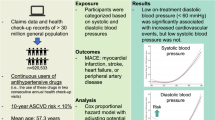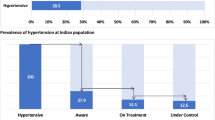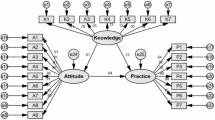Abstract
Little is known about patient awareness of nationally recommended blood pressure targets, especially among patients with cardiac disease. To examine this issue, we interviewed 738 patients hospitalized with coronary artery disease to assess their knowledge of their systolic and diastolic blood pressure levels as well as corresponding national targets. We used bivariate and multivariate analyses to determine if any patient demographic or clinical characteristics were associated with blood pressure knowledge. Only 66.1% of patients could recall their own systolic and diastolic blood pressure levels. Only 48.9% of all patients could correctly name targets for these values. Knowledge of target blood pressure levels was particularly poor among patients who were female (odds ratio (OR) 0.69; 95% confidence interval (CI) 0.49–0.98), aged ⩾60 years (OR 0.70, CI 0.51–0.97), without any college education (OR 0.48, CI 0.35–0.65), without a documented history of hypertension (OR 0.57, CI 0.39–0.84), and with known diabetes (OR 0.46, CI 0.33–0.66). Patients in the highest risk group, according to Joint National Committee guidelines stratification, were no more knowledgeable about their blood pressure levels and targets than lower risk patients. A significant proportion of patients hospitalized with coronary artery disease do not know their own blood pressure levels or targets. Current blood pressure education efforts appear inadequate, particularly for certain patient subgroups in which hypertension is an important modifiable risk factor.
This is a preview of subscription content, access via your institution
Access options
Subscribe to this journal
Receive 12 digital issues and online access to articles
$119.00 per year
only $9.92 per issue
Buy this article
- Purchase on SpringerLink
- Instant access to full article PDF
Prices may be subject to local taxes which are calculated during checkout
Similar content being viewed by others
References
Fields LE et al. The burden of adult hypertension in the United States 1999 to 2000: a rising tide. Hypertension 2004; 44: 398–404.
Hajjar I, Kotchen TA . Trends in prevalence, awareness, treatment, and control of hypertension in the United States, 1988–2000. JAMA 2003; 290: 199–206.
American Heart Association. 2002 Heart and Stroke Statistical Update. American Heart Association: Dallas, TX, 2001.
National High Blood Pressure Education Program. Patient behavior for blood pressure control. Guidelines for professionals. JAMA 1979; 241: 2534–2537.
Joint National Committee on Prevention, Detection, Evaluation, and Treatment of High Blood Pressure. The sixth report of the Joint National Committee on Prevention, Detection, Evaluation, and Treatment of high blood pressure. Arch Intern Med 1997; 157: 2413–2446.
Chobanian AV et al. The seventh report of the Joint National Committee on Prevention, Detection, Evaluation, and Treatment of High Blood Pressure: the JNC 7 report. JAMA 2003; 289: 2560–2572.
Joint National Committee on Detection, Evaluation, and Treatment of High Blood Pressure. Report of the Joint National Committee on Detection, Evaluation, and Treatment of high blood pressure. A cooperative study. JAMA 1977; 237: 255–261.
Burt VL et al. Trends in the prevalence, awareness, treatment, and control of hypertension in the adult US population. Data from the health examination surveys, 1960 to 1991. Hypertension 1995; 26: 60–69.
Nieto FJ et al. Population awareness and control of hypertension and hypercholesterolemia. The Atherosclerosis Risk in Communities study. Arch Intern Med 1995; 155: 677–684.
Stockwell DH et al. The determinants of hypertension awareness, treatment, and control in an insured population. Am J Public Health 1994; 84: 1768–1774.
Lichtman JH et al. Clinical trial of an educational intervention to achieve recommended cholesterol levels in patients with coronary artery disease. Am Heart J 2004; 147: 522–528.
Miller NH, Hill M, Kottke T, Ockene IS . The multilevel compliance challenge: recommendations for a call to action. A statement for healthcare professionals. Circulation 1997; 95: 1085–1090.
National High Blood Pressure Education Program. National High Blood Pressure Education Program Working Group report on hypertension in diabetes. Hypertension 1994; 23: 145–158; discussion 159–160.
Geiss LS, Rolka DB, Engelgau MM . Elevated blood pressure among U.S. adults with diabetes, 1988–1994. Am J Prev Med 2002; 22: 42–48.
Hyman DJ, Pavlik VN . Characteristics of patients with uncontrolled hypertension in the United States. N Engl J Med 2001; 345: 479–486.
Legato MJ, Padus E, Slaughter E . Women's perceptions of their general health, with special reference to their risk of coronary artery disease: results of a national telephone survey. J Womens Health 1997; 6: 189–198.
Wenger NK, Speroff L, Packard B . Cardiovascular health and disease in women. N Engl J Med 1993; 329: 247–256.
Ruland S et al. Awareness, treatment, and control of vascular risk factors in African Americans with stroke. Neurology 2003; 60: 64–68.
Freeman V, Rotimi C, Cooper R . Hypertension prevalence, awareness, treatment, and control among African Americans in the 1990s: estimates from the Maywood Cardiovascular Survey. Am J Prev Med 1996; 12: 177–185.
Psaty BM et al. Time trends in high blood pressure control and the use of antihypertensive medications in older adults: the Cardiovascular Health Study. Arch Intern Med 2002; 162: 2325–2332.
Barker WH, Mullooly JP, Linton KL . Trends in hypertension prevalence, treatment, and control: in a well-defined older population. Hypertension 1998; 31: 552–559.
National High Blood Pressure Education Program Working Group. National High Blood Pressure Education Program Working Group report on hypertension in the elderly. Hypertension 1994; 23: 275–285.
Gazmararian JA, Williams MV, Peel J, Baker DW . Health literacy and knowledge of chronic disease. Patient Educ Couns 2003; 51: 267–275.
Giles WH et al. The validity of self-reported hypertension and correlates of hypertension awareness among blacks and whites within the stroke belt. Am J Prev Med 1995; 11: 163–169.
Meissner I et al. Detection and control of high blood pressure in the community: do we need a wake-up call? Hypertension 1999; 34: 466–471.
Acknowledgements
This study was supported by a grant from Pfizer. Dr Lichtman is a Goddess Fund Career Development Scholar. There are no relationships that could be perceived as real or apparent conflict(s) of interest with regard to the subject matter of this manuscript.
Author information
Authors and Affiliations
Corresponding author
Rights and permissions
About this article
Cite this article
Cheng, S., Lichtman, J., Amatruda, J. et al. Knowledge of blood pressure levels and targets in patients with coronary artery disease in the USA. J Hum Hypertens 19, 769–774 (2005). https://doi.org/10.1038/sj.jhh.1001895
Received:
Revised:
Accepted:
Published:
Issue date:
DOI: https://doi.org/10.1038/sj.jhh.1001895
Keywords
This article is cited by
-
Racial/Ethnic Differences in Knowledge of Personal and Target Levels of Cardiovascular Health Indicators
Journal of Community Health (2015)
-
Risk factor awareness in a coronary population and the association with health-related quality of life outcomes
International Journal of Public Health (2014)
-
Management of hypertension in patients with coronary artery disease
Current Hypertension Reports (2008)
-
Towards improving the clinical assessment and management of human hypertension: an overview from this Journal
Journal of Human Hypertension (2006)
-
Reduction of cardiovascular risk and mortality: A population-based approach
Advances in Therapy (2006)



